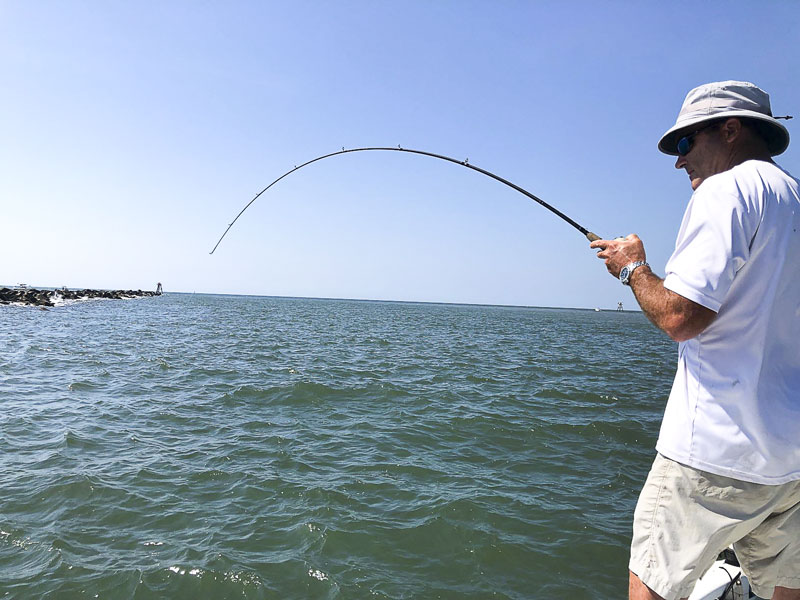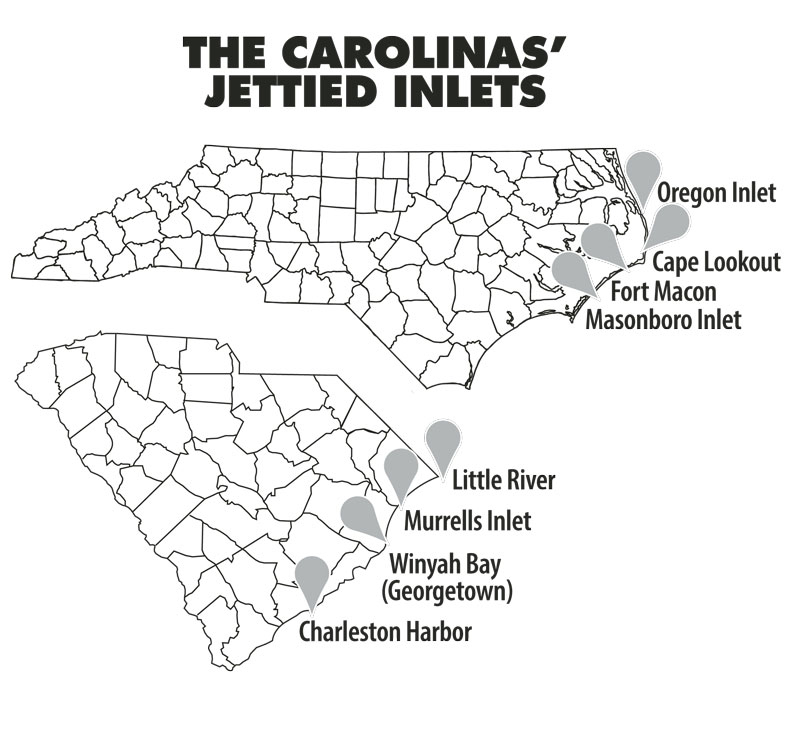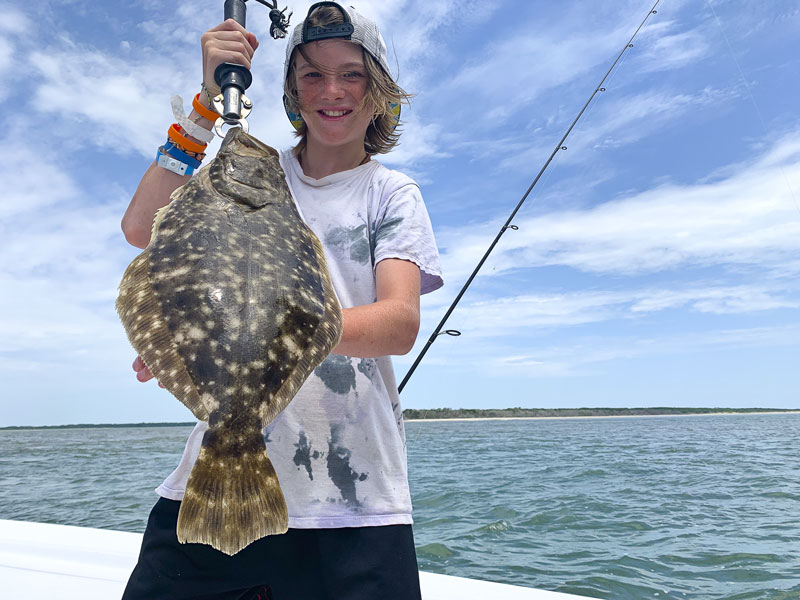
When summer heat warms the water, rock jetties that line the entrance to coastal inlets become havens for baitfish and predators of all kinds. Here’s how to set up for success.
The Carolinas offer excellent opportunities for a long list of saltwater fish species throughout the year.
The seemingly endless myriad of creeks and shallow estuaries painted along the eastern front provides the perfect feeding grounds for every member of the food chain, from mud minnows, pinfish and creek shrimp on the low end to the gator trout, snaggle-toothed sheepshead and lunker reds on the top end.
But as the sun’s rays pelt down 14 hours a day, water temperatures soar along the shallow front. The once-perfect scenario becomes less than ideal for larger gamefish. And cooler water becomes attractive along the oceanic fringe. So the rock jetties that line a number of inlets provide just the right pieces to the puzzle. And they become new feeding grounds for many of these fish.

No doubt, the water gets hot all over the place. But the vastness of the ocean moderates temperatures. It provides relative refuge for many marine creatures. Scattered inlets are ideal places for fish to feed, and inlets armored with rock jetties provide everything a predator can ask for. Jetties provide a surface for barnacles, oysters and marsh mussels to grow and perfect places for shrimp and small fish to hide. Predators find these areas quite useful. And they can make a living eating breakfast, lunch, dinner and plenty of late-night snacks.
Numerous species flock to jetties in hot weather
Jordan Pate of Carolina Guide Service fishes just about every type of marine terrain around Georgetown, S.C., throughout the year. When the water heats up, the jetties lining the entrance to Winyah Bay become two of his prime destinations.
“I rely on jetty fishing in the hottest part of the summer, particularly when the water temps get really hot in the creeks,” said Pate (843-814-7900). “You can literally catch every type of inshore gamefish at the jetties, as well as your apex predators, like kings, tarpon, cobia and sharks. I like to fish the jetties because you never know what you’re going to catch.”
 The Winyah Bay jetties are some of the largest and longest jetties along the entire Eastern Seaboard. They easily extend more than a mile into the ocean. They play an important role in armoring the entrance to the bay, where four river systems converge and empty into the Atlantic. Currents can be strong and sometimes unpredictable at the jetties. But tons of places offer anglers opportunities to safely set up and find feeding fish. Tides and currents play a major role on boat placement.
The Winyah Bay jetties are some of the largest and longest jetties along the entire Eastern Seaboard. They easily extend more than a mile into the ocean. They play an important role in armoring the entrance to the bay, where four river systems converge and empty into the Atlantic. Currents can be strong and sometimes unpredictable at the jetties. But tons of places offer anglers opportunities to safely set up and find feeding fish. Tides and currents play a major role on boat placement.
Both sides of rock jetties hold fish
“I find places along the rocks where I can fish comfortably while avoiding a dangerous situation,” Pate said.
Luckily, target species are available on both sides of the jetty for most of their length. Pate typically targets flounder, sheepshead, black drum and redfish, which prefer the cooler waters around the jetties, and a wide-open menu of forage foods will be available in summer. He will use live bait and artificials throughout the year, but for the mixed bag of predators, live bait is hard to beat around the jetty rocks.
“Reds, trout and flounder will gobble up a live shrimp or small fish without hesitation,” he said. “I like to float them on an adjustable float around the jetty rocks.”
In addition to the rocks themselves, the sea floor around the jetties is littered with unfriendly objects to snag and cut off rigs. Adjustable floats allow anglers to dangle live baits just above the structure in just the right position. Speckled trout, redfish and flounder will come off the bottom as soon as they see one of these free meals dangling on the dinner table.
Visibility is an important factor while fishing the jetties. And the water will be clearer at some times more than others during summer.
Clean water is usually better than dingy at rock jetties
“Different tides favor different species at times, but in general, fish tend to bite better in the cleaner water, particularly, flounder and trout, which rely on their eyesight to locate prey,” Pate said. “A rising tide pushes clean water into the rocks and makes fishing better.”

Sheepshead also feed by sight. So cleaner water provides a better opportunity for these fish. Pate catches sheepshead on live shrimp under a float. He also tosses live fiddler crabs into the rocks on jigheads or light Carolina rigs.
The falling tide can also be a good time to catch fish at the jetties. The outgoing current exposes the rocks and confines bait and predators in smaller areas. The outgoing current also flushes more food out of the estuaries, so lower water can be productive around jetties.
“Whether you are fishing the rising or the falling tide, fish bite better in the cleaner water,” he said.
Stay on the move because the fish do too
Pate patrols both sides of the jetties, choosing to fish places with cleaner water first. And he’ll keep moving until he finds a productive spot. Currents, tides and water clarity change frequently throughout a day. So the best places to find fish will also change. Pate recommends staying mobile, using your trolling motor to move around looking for a consistent bite.
“Trout, flounder, redfish and sheepshead shift around from one set of rocks to another to take advantage of the conditions. We have to do that too,” he said.
Summer can be a challenging time for inshore anglers. But it doesn’t have to be, because the jetties provide an excellent feeding ground for inshore species such as flounder, trout, redfish, and sheepshead. Cool water, abundant food, and ample cover is the perfect combination. Making the choice to fish the jetties in the summertime can be a real winner for anglers in the Carolinas. Make the right choice and put fish on the table.

Apex predators like jetties, too
Jetties that line the entrance to inlets are prime spots to target trout, redfish, sheepshead and flounder in the summer. But there is always something bigger out there, too.
Even though redfish and trout are predators, they can also easily be prey. That’s especially true around jetties. Bigger predators flourish there during summer. And that can make an interesting day if you have a baitwell full of live menhaden.
Apex predators such as king mackerel, tarpon, cobia and sharks love to camp out in and around jetties because the food is practically endless. Jordan Pate of Carolina Guide Service spends many summer days fishing the jetties at the entrance to Winyah Bay, downstream from Georgetown, S.C. On most summer days, Pate will aim for an inshore slam — reds, trout, flounder — but he will quickly shift gears when a group of silver kings shows up on his radar. Targeting a 100-pound tarpon is a favorite summer option, and the jetties are a perfect place to find these beasts.
“Our tarpon generally arrive in July and (are) available until the early fall,” Pate said. “The jetties can be an ideal place for tarpon because of all of the available bait in this area.”
Anglers catch some giant fish along the jetties
Beyond tarpon, the jetties are frequently visited by big sharks, cobia, and king mackerel, and for the same reasons.
“The jetties are full of bait and feeding opportunities for these apex predators. We have fun floating or slow-trolling live menhaden at the jetties because you never know what is going to take it down. It could be a cobia, king mackerel, tarpon or a 200-pound shark,” he said.
While Pate fishes all tides at the jetties, he prefers falling water for these big guys.
“The falling tide can often be better for kings, tarpon and the big sharks because of the steady stream of bait coming out of the inlet,” said Pate, who will fish along the rocks, the current seams and the tidelines at the ends of the jetties, too.





Be the first to comment